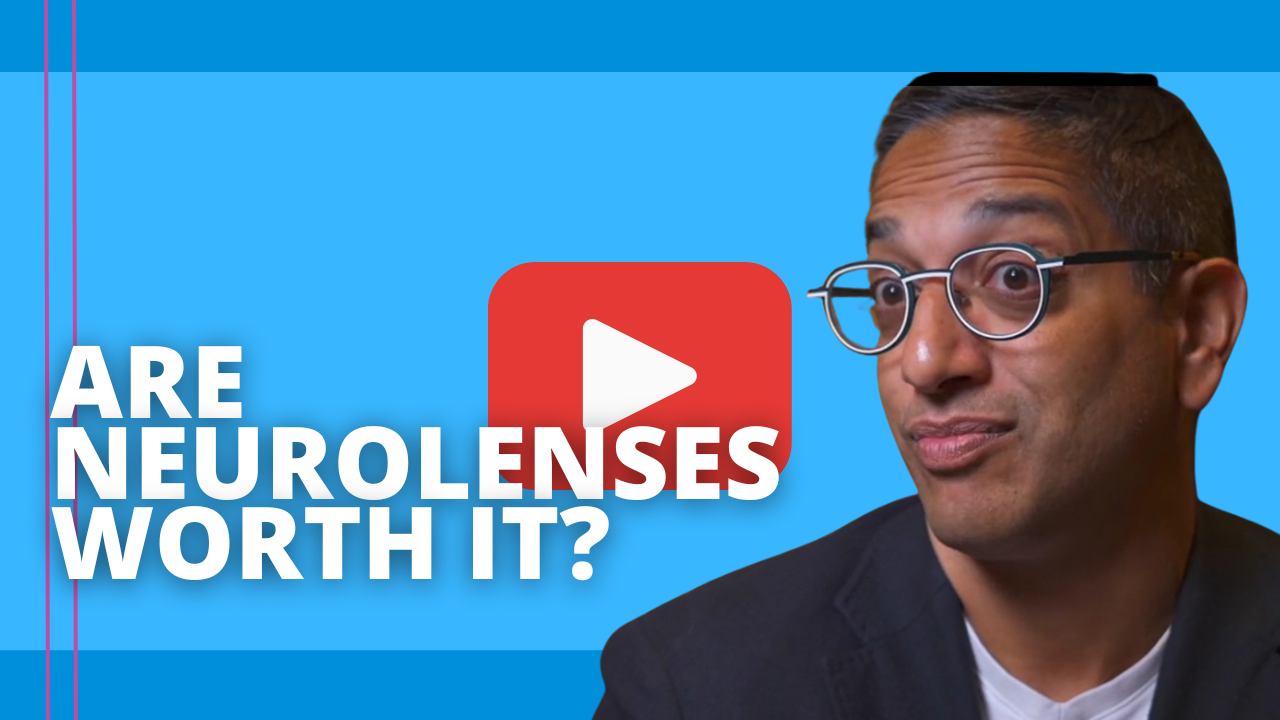.png)
Are Neurolenses Worth It?
Are Neurolenses worth it? Hear from prominent eye care professionals and patients on how Neurolenses have transformed their practices and their lives!
As the way we use our eyes continues to evolve, binocularity is becoming an even more important part of vision care, and even overall wellness. Most people have some sort of misalignment—or phoria—and almost 90% of patients are more misaligned at near. This makes sense evolutionarily because our eyes are not suited to stare at things at close distances for long periods of time. Lifestyles have changed dramatically, and people statistically spend most of their waking hours looking at screens. This leads to symptoms that we commonly bucket into the term “Digital Vision Syndrome”; symptoms like headaches, eye strain, neck pain, dizziness, and even dry eye sensation. In fact, a 2022 study by The Vision Council reported that 80% of patients now experience these symptoms with some regularity.
Very few patients volunteer this information to their eyecare provider. Why? Because most patients don’t know that these symptoms are connected to their vision.
Looking at things up close requires us to compensate for the distance between where our eyes naturally rest and where we need them to focus. Fusional reserves cover this compensation work for some period of time—which varies from person to person—but not for hours on end. Some eyecare providers have likened using your near vision all day to holding a 5-pound weight all day. Simple at first, but increasingly tiresome and painful over time.
So how exactly does misalignment lead to symptoms. The answer lies in the trigeminal nerve—the largest nerve in the brain and the one responsible for most head, face, jaw and neck sensations. Importantly, proprioceptive information is sent to brain via the trigeminal nerve. When there is a proprioceptive mismatch between misaligned eyes and your vestibular and muscular systems, this creates a neural conflict and leads to an inaccurate gaze response. This inaccurate response is continuously fed back to the visual system, which ultimately leads to the overstimulation of the trigeminal nerve. This overstimulation leads to a painful stimulation of several parts of the face and neck.
Neurolens addresses these symptoms by determining the answer to three key questions:
- One, how do we efficiently identify which patients need binocular vision solutions?
- Two, how do we accurately and objectively measure a patient’s level of misalignment?
- Three, how do we effectively correct that misalignment?
There are several methods for measuring eye misalignment; so why isn’t prism much more common in glasses? Simple. Because all these methods are incredibly subjective and inconsistent. Studies have found inter-examiner repeatability can deviate 2-3 prism diopters for these manual methods. Alternatively, the Neurolens Measurement Device, Gen 2—or NMD2—is accurate to the 100th prism diopter.
But the most important part of the Neurolens process is the Neurolenses themselves. Patients need more help at near, so Neurolenses incorporate a contoured prism into the lens. And multiple studies have found that even small amounts of prism have a profound impact on a patient’s visual clarity and comfort.
In fact, Neurolenses consistently offer relief in the 80-90% range, depending on symptom. Imagine the impact this level of relief has on a patient. And they’re risk free with a lifetime satisfaction guarantee. But these lenses work so well for so many people that the national return rate is less than 3%.
Video: The impact of Neurolens on practices and patients!
So, are Neurolenses worth it? Yes. Neurolenses will unlock a new dimension of patient care for your practice, unlocking patient outcomes like you’ve never seen, as well as unlocking truly impactful practice revenue growth.
Long story short, Neurolenses are a gamechanger for patients and eye care providers alike, and are becoming a new standard of care in the vision industry. Giving providers tools to help those they couldn't before, and offering patients the only proven therapeutic solution to combat the painful symptoms of eye misalignment!
Other Resources
Click here to read a double-masked study on Neurolenses and reading speed.
Click here to read a white paper study on small prism corrections.
Click here to read a study on Neurolenses with chronic daily headache patients.

Neurolens Marketing
Nearly 2/3 of adults experience the painful symptoms of eye misalignment, including chronic headaches, neck pain, eye strain and dry eye sensation. Fortunately, relief is in sight with Neurolenses, which go beyond visual acuity to restore naturally comfortable vision.

.png?width=352&height=222&name=Neurolens%20Measures%20(2).png)
.png?width=352&height=222&name=brfeaturedimage%20(13).png)
.png?width=352&height=222&name=brfeaturedimage%20(2).png)